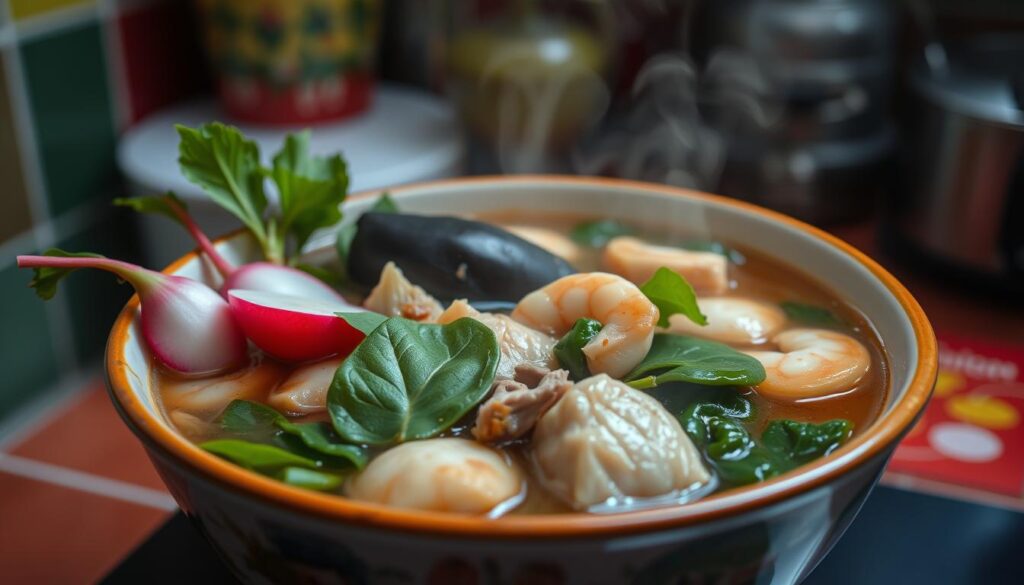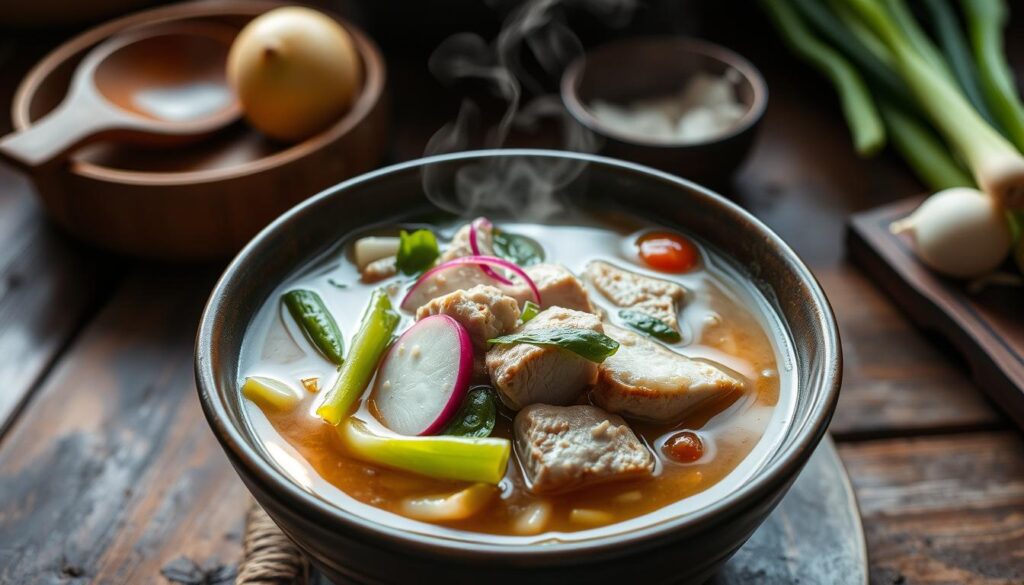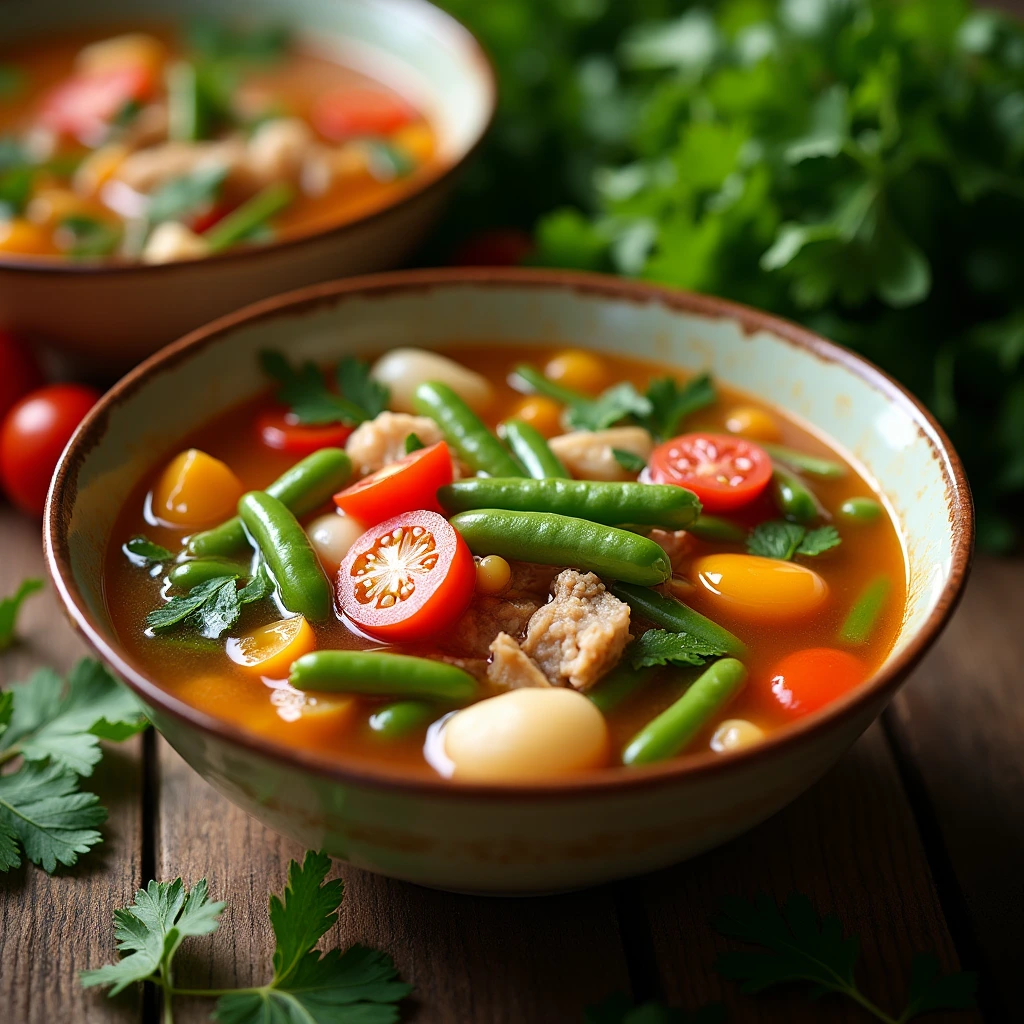Sinigang, a traditional Filipino sour soup, is loved for its rich flavors and health benefits. It’s made with fresh veggies and protein, making it a nutritious meal. You can make it in about 30 minutes, perfect for quick, healthy meals.
As we dive into sinigang’s benefits, we’ll look at its nutritional values and key ingredients. We’ll also explore its cultural importance and how it’s adapted in modern diets. This makes it a favorite for many.

Key Takeaways
- Sinigang is rich in vitamins and minerals, supporting overall health.
- This sour soup can boost digestion and promote gut health.
- Using fresh ingredients makes sinigang a nutritious choice for meals.
- Protein options like pork or shrimp enhance the dish’s health benefits.
- Variations of sinigang can cater to vegetarian and vegan diets.
- Quick preparation makes it accessible for busy individuals.
- Cultural significance adds to the enjoyment of sinigang at family gatherings.
Introduction to Sinigang
Sinigang is a favorite in Filipino food, known for its sour and savory taste. It comes from tamarind. This dish is a comfort for many families in the Philippines.
It can have different proteins like fish, pork, beef, shrimp, or chicken. This makes it appealing to many.
Various souring agents like unripe mangoes and rice vinegar add to its tanginess. Vegetables like okra and taro corms add flavor and nutrition. There’s also a version called Sinigáng sa misô, with miso for extra umami.
In 2021, sinigang was named the best soup by TasteAtlas Awards. It was also one of the Best Dishes in the World in 2023. A traditional pork sinigang recipe serves 6-8 people, great for parties.
It’s easy to make, needing just 15 minutes to prepare and 45 minutes to cook. It uses simple ingredients like pork, tomatoes, and onions. Many love its rich flavors.

Historical Significance of Sinigang
Sinigang is a key part of Filipino culinary history. It has brought families and communities together for generations. Its roots go back to the pre-colonial Philippines, where indigenous people mixed local ingredients with special cooking methods.
Tamarind is the main sour ingredient in sinigang. Its acidity gives the dish its sour taste, loved by many. Over time, sinigang has grown to include different proteins like pork, beef, and shrimp. It also features various vegetables, such as eggplant and tomatoes, adding to its flavor.
During colonial times, sinigang picked up influences from different cultures. This made its ingredients and cooking methods richer. Today, you can find many sinigang variations, like sinigang na hipon (shrimp) and sinigang na baboy (pork), showing the diversity in Filipino cooking.
Sinigang holds a special place in Filipino culture. It’s often served during rainy seasons or at big events like birthdays and weddings. This highlights its role as more than just food. It represents the warmth of Filipino hospitality and tradition. Sinigang shows how Filipino cooking has adapted and evolved, blending old traditions with new flavors.

| Aspects | Details |
|---|---|
| Origins | Pre-colonial indigenous roots |
| Main Ingredient | Tamarind – souring agent |
| Protein Options | Pork, beef, chicken, shrimp, fish |
| Common Vegetables | Okra, eggplant, tomatoes |
| Variations | Sinigang na hipon, sinigang na baboy |
| Cultural Significance | Served in rainy seasons, celebrations |
What Are the Benefits of Eating Sinigang?
Sinigang is more than just a tasty dish—it’s packed with health benefits. This traditional Filipino soup is full of ingredients that are good for you. It’s a great choice for meals because it offers essential nutrients and supports well-being.
Rich in Nutrients and Vitamins
The ingredients in sinigang are full of nutrients. Vegetables like tomatoes, spinach, and radish are rich in vitamins C and A. Radish adds potassium, fiber, and antioxidants, which are good for your health.
Taro, another key ingredient, is packed with minerals and vitamins like calcium and folate. Each bowl of sinigang can help meet your daily nutrient needs.
Supports Digestive Health
Sinigang is great for your digestive health. The sour taste from tamarind helps boost digestive enzymes. This makes digestion better.
The high fiber content in the vegetables and tamarind helps with regular bowel movements. It also helps detoxify your body. Eating sinigang regularly can keep your digestive system healthy.
Boosts Immune System
Eating sinigang can boost your immune system. Ingredients like tamarind and various vegetables help strengthen your body’s defenses. Vitamin C from tomatoes and potassium from radish improve immune function.
This nutritious dish not only warms your soul but also strengthens your body’s defenses against illnesses.
Key Ingredients in Sinigang
Sinigang is famous for its bright flavors and warm broth. This comes from a mix of key ingredients. Each part adds to the dish’s taste and health perks. Knowing these ingredients shows why sinigang is a beloved Filipino dish.
Tamarind: The Sour Base
Tamarind is the main sour ingredient in sinigang, giving it a tangy taste. It’s full of antioxidants and vitamins, helping with digestion. While tamarind is common, other fruits like guava or calamansi can also be used, showing the dish’s flexibility.
Meat and Seafood Choices
Sinigang can have different proteins, with pork being traditional. Beef, shrimp, and fish are also popular, each bringing unique flavors. These ingredients add nutrients like omega-3s from seafood. Using tougher cuts like pork shoulder or beef brisket makes the meat tender.
Vegetables and Their Benefits
Many colorful vegetables make sinigang nutritious and appealing. Daikon radish, okra, water spinach, and long beans are common. They add vitamins and minerals, making the dish healthier. Cooking times are adjusted so the veggies stay fresh and flavorful.
| Ingredient | Type | Benefits |
|---|---|---|
| Tamarind | Souring agent | Rich in antioxidants, aids digestion |
| Pork Belly | Meat | Rich in protein and fats, tenderizes well |
| Shrimp | Seafood | High in omega-3 fatty acids, low in calories |
| Daikon Radish | Vegetable | Aids digestion, low in calories |
| Okra | Vegetable | High in vitamins K and C, adds texture |
| Water Spinach | Vegetable | Rich in iron, enhances flavor |
Health Benefits of the Main Ingredients
Sinigang, a favorite Filipino soup, is loved for its sour taste and health perks. Each ingredient adds vital nutrients that boost well-being. Let’s dive into the health benefits of sinigang’s main parts.
Nutritional Benefits of Tamarind
Tamarind is a key player in sinigang, packed with vitamins and minerals. It’s rich in magnesium, potassium, and B vitamins. These help keep the heart healthy and support overall wellness.
Moreover, tamarind boosts the immune system with its high vitamin C. This makes it a key player in sinigang’s health benefits.
Advantages of Seafood in Sinigang
Seafood in sinigang offers big health pluses, especially with fatty fish. These are full of omega-3 fatty acids. Omega-3s are good for the heart and brain.
Seafood makes sinigang a balanced meal. It adds proteins and healthy fats for energy and vitality.
Vitamins from Vegetables
Vegetables like radish, okra, and water spinach add to sinigang’s nutritional value. They bring antioxidants and minerals. These support eye health, boost the immune system, and help with digestion.
Cooking Methods for Healthy Sinigang
Making a tasty sinigang is all about using fresh ingredients and the right cooking methods. It’s important to mix old ways with new to keep the dish’s true taste.
Using Fresh Ingredients
Fresh sinigang ingredients are key for the best flavor and health benefits. Choosing seasonal, local veggies makes the meal taste better and is healthier. Tamarind, pork spare ribs, and bright greens add to the soup’s charm.
Traditional vs. Modern Cooking Techniques
Old ways of cooking sinigang involve slow simmering. This method lets flavors mix well over time, creating a deep broth. On the other hand, modern methods like pressure cooking save time without losing flavor or nutrition. Both ways keep the dish’s spirit alive, fitting into today’s busy lives.
| Cooking Method | Description | Flavor Impact | Time Required |
|---|---|---|---|
| Traditional Simmering | Slow cooking to blend flavors | Rich and deep | 1 hour |
| Pressure Cooking | Rapid cooking under pressure | Retains essence, efficient | 30 minutes |
Popular Variations of Sinigang
Sinigang, the beloved Filipino sour soup, has many variations. Each one highlights the unique tastes and ingredients of different regions. You can find Sinigang na Baboy with tender pork and Sinigang na Hipon with succulent shrimp.
Some unique sinigang options use guava for a special twist. For example, Sinigang na Baboy sa Bayabas combines guava’s sweetness with sour notes. Vegetarian sinigang, with tofu or mushrooms, is also popular among health-conscious diners.
Sinigang often includes a mix of proteins like beef, chicken, and seafood. This adds depth to its flavor. Traditional vegetables like taro, kangkong, eggplant, and radish are also key. The use of souring agents like tamarind, calamansi, and green mangoes shows how sinigang can be tailored to individual tastes.
| Variation | Main Protein | Souring Agent | Key Vegetables |
|---|---|---|---|
| Sinigang na Baboy | Pork | Tamarind | Taro, Kangkong, Eggplant |
| Sinigang na Hipon | Shrimp | Calamansi | Okra, Radish, Spinach |
| Sinigang na Baboy sa Bayabas | Pork | Guava | White Radish, String Beans |
| Vegetarian Sinigang | Tofu | Tamarind | Mixed Vegetables |
Sinigang’s adaptability makes it a favorite in Filipino cuisine. Its sour flavor profile is calming and encourages people to try different sinigang variations.
How to Make Sinigang at Home
Making sinigang at home is a fun cooking adventure. It lets you enjoy this tasty Filipino dish just like it’s meant to be. Start by boiling water with onions and tomatoes to make a tasty base. Then, pick your favorite protein like pork, seafood, or tofu.
To get that tangy taste, add a souring agent like tamarind, calamansi, or green mango. These add to the dish’s unique flavor. Next, add seasonal veggies like water spinach, eggplant, and okra for more taste and nutrition.
Here’s a simple overview of sinigang cooking instructions:
- Boil 2 lbs of your chosen meat (like pork belly) with some water for about 25 minutes.
- Add in taro for an additional 30 minutes of cooking.
- Include vegetables like daikon radish, cooking them for 3 to 5 minutes.
- Finish off with quick-cooking items like chili peppers and kangkong, which take just a few minutes.
Each serving feeds 2 to 3 people, perfect for family meals. You can tweak the flavors with fish sauce, black pepper, or other seasonings. This makes sinigang easy to customize to your taste. Get ready to enjoy a warm, comforting bowl of soup that brings you closer to Filipino culture.
Serving Sinigang: Best Practices
Serving sinigang can make your mealtime better. This Filipino dish is not just tasty but also a chance to show off your meal presentation. Good serving practices make sinigang more enjoyable, highlighting its cultural value.
Accompaniments and Pairings
To make sinigang even better, try these traditional sides:
- Fish sauce for an extra umami taste.
- Calamansi for a fresh citrus flavor.
- Chili peppers for a spicy kick.
White rice is a common side, balancing the tangy soup. Grilled or fried fish pairs well with sinigang, enhancing the flavor.
Presentation Tips
For a beautiful sinigang presentation, serve it hot in deep bowls. Add:
- Fresh herbs like cilantro or scallions for color.
- Sliced chili for both taste and looks.
A colorful platter with various vegetables or fish adds to the meal’s appeal. It makes the dish both tasty and visually stunning.
Experiencing the Filipino Culture Through Sinigang
Sinigang is more than a dish; it’s a symbol of Filipino culture and hospitality. It’s often called the unofficial national dish of the Philippines. Its importance in family traditions is deep.
Sharing sinigang during meals brings families together, showing unity and warmth. It’s a key part of many households.
This dish captures the heart of Filipino life. Ingredients like sampalok (tamarind), water spinach, and meats show the country’s rich agriculture. Taste Atlas named it the world’s best vegetable soup, praising its mix of vegetables and sour flavors.
Sinigang is a comfort food loved by many Filipinos. Its cool and tangy taste is perfect for the tropical climate. Families make it their own, adding local touches and adjusting the sourness.
This dish brings people together, creating lasting memories. It’s a big part of celebrations and everyday life. Enjoying sinigang with loved ones deepens our understanding of Filipino culture and its significance.
Conclusion
Sinigang is a delicious mix of taste and health, loved by many in the Philippines. It has a long history, showing how Filipino cooking has changed over time. The main ingredient, tamarind, is packed with nutrients that help keep us healthy.
Adding sinigang to your meals brings more than just flavor. It boosts digestion, strengthens the immune system, and gives us important vitamins and minerals. Whether you like pork, seafood, or veggies, there’s a sinigang for everyone.
Enjoying sinigang is more than just eating. It connects us to our cultural roots, celebrating food that brings people together. Regularly having sinigang can improve our health and let us savor the rich tastes of Filipino food.
FAQ
What are the health benefits of sinigang?
Sinigang is packed with nutrients and vitamins from its vegetables. It helps with digestion thanks to tamarind. Plus, it boosts your immune system with antioxidants.
What key ingredients are used in a traditional sinigang recipe?
Traditional sinigang uses tamarind as the sour base. It also includes meat or seafood like pork, shrimp, or catfish. Tomatoes, long beans, and spinach are the vegetables used.
How can I make sinigang at home?
To make sinigang at home, start by boiling water with onions and tomatoes. Add your meat and tamarind, then the vegetables. Cook until everything is tender. Serve it hot with rice.
Are there any popular variations of sinigang?
Yes, there are many variations. Sinigang na Baboy (pork) and Sinigang na Hipon (shrimp) are favorites. There are also vegetarian options with tofu or mushrooms. Each version brings its own flavor while keeping the sinigang essence.
What accompaniments work best with sinigang?
Fish sauce, calamansi, and chili peppers are great with sinigang. They add to its tangy taste. Serving it with white rice helps balance the flavors.
How can I improve the presentation of sinigang?
To make sinigang look better, serve it hot in deep bowls. Add fresh herbs and sliced chili for garnish. A side platter of fish or vegetables can also add color and appeal.
What role does sinigang play in Filipino culture?
Sinigang is a symbol of Filipino hospitality and family traditions. Sharing it during meals brings families together. It creates lasting memories and connects generations through its comforting flavors.

